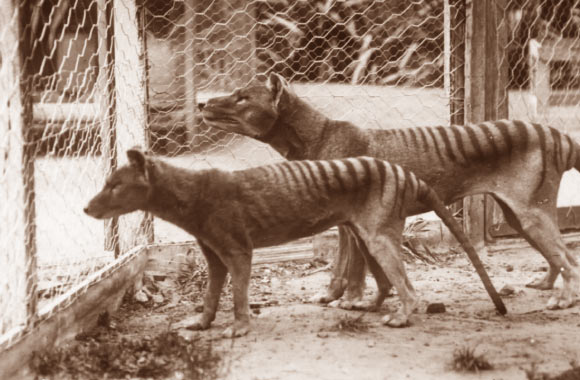Until its extinction, the thylacine (Thylacinus cynocephalus) was the largest living carnivorous marsupial, but little data exist regarding its body mass, with an average of 29.5 kg the most commonly used estimate. However, a new study shows the extinct predator, also known as the Tasmanian tiger, only weighed about 16.7 kg on average.

Tasmanian tigers (Thylacinus cynocephalus) in captivity. Image credit: University of Melbourne / Museums Victoria.
Despite extinction in the 1930s and film footage, the thylacine is a true enigma with almost no direct observations supporting an understanding of their behavior and biology.
Only four reliable records of its body mass can be found in the peer-reviewed literature: 15 kg for an ‘excessively fat’ male; a 14.97 kg male, and two records from the 1914 death registry of the London Zoo, a 13.2 kg female and a 26.1 kg male.
Beyond these four records, reported thylacine body masses are scant, anecdotal, and problematic, leaving scientists with no clear record of adult body mass.
“We wish we could watch just how the thylacine hunted, and what sort of prey it could take — this is our closest look yet at an essential ingredient of the predator’s behavior, how big it really was,” said co-author Dr. Alistair Evans, a researcher in the School of Biological Sciences at Monash University and Museums Victoria.
Using traditional measurement techniques, advanced 3D scanning and volumetric methods, Dr. Evans and colleagues estimated body mass for 93 adult thylacines, including two taxidermy specimens and four complete mounted skeletons, representing 40 known-sex specimens.
The scientists established that there were strong differences in the average male and female body size, with the male mean of 19.7 kg and female mean of 13.7 kg.
The mixed sex population mean of 16.7 kilograms is then well below the 21 kg threshold for when predators are likely to take large prey.
“We demonstrate strong differences in average male and female body size,”
Adams
“This result also fundamentally challenges prior views about the thylacines as a carnivore, and underscores that thylacines were a predator that evolved to consume prey smaller than themselves.”
The newly established body mass estimates for thylacines place them as specialists on small prey, challenging prior interpretations of them as convergent with species like wolves that specialise in pack-hunting prey substantially larger than themselves.
“Rewriting the thylacine as a smaller animal changes the way we look at its position in the Australian ecosystem — because what a predator can (and needs to) eat is very much dependent on just how big they are,” said lead author Douglass Rovinsky, a Ph.D. student in the Department of Anatomy and Developmental Biology, Biomedicine Discovery Institute, Monash University
“Many of the 19th century newspaper reports just might have been ‘tall tales’ — told to make the thylacine seem bigger, more impressive… and more dangerous!”
The results were published in the Proceedings of the Royal Society B.
_____
Douglass S. Rovinsky et al. 2020. Did the thylacine violate the costs of carnivory? Body mass and sexual dimorphism of an iconic Australian marsupial. Proc. R. Soc. B 287 (1933): 20201537; doi: 10.1098/rspb.2020.1537







